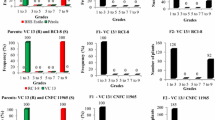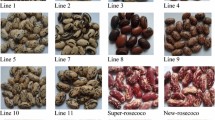Abstract
Fusarium root rot (FRR) is a major disease of common bean worldwide. Knowledge of the inheritance of resistance to FRR would be important in devising strategies to breed resistant varieties. Therefore, a 12 × 12 full diallel mating scheme with reciprocal crosses was performed to generate 132 F1 progenies, which were then advanced to the F3. The progenies were evaluated for resistance to FRR under green house conditions in Uganda. General combining ability (GCA) effects were highly significant (P ≤ 0.01) for disease scores. Specific combining ability effects were not significant (P > 0.05) in the F1, but were highly significant (P < 0.01) in the F3 generation. These results indicate that resistance to FRR was governed by genes with additive effects in combination with genes with non-additive effects. Reciprocal differences were also significant (P = 0.01) at F1 and F3, primarily reflecting a large influence of maternal effects in both these generations. In fact, susceptible parents did not differ significantly (P > 0.05) for disease scores when used as paternal parents in the F3, but differed strongly as maternal parents (P = 0.0002). Generally, the progenies were distinctly more resistant when the resistant parent was used as the female in crosses, especially as observed in the F3. The maternal effects were strong in the F3 generation, suggesting a complex form of cytoplasmic–genetic interaction. The non-maternal reciprocal effects in the F3 were significant (P < 0.05) in both the resistant × resistant diallel, and in the resistant × susceptible crosses. Mid-parent heterosis (MPH) occurred in most crosses, with average heterosis approximately equal in each of the three generations, indicating that epistasis was probably more influential than dominance of individual genes. Gene-number formulas indicated that several genes were involved in resistant × susceptible crosses. Among resistant × resistant crosses, many produced continuous distributions of F1 progeny scores, suggesting polygenic inheritance, while bi-modal distributions were characteristic of the F3 distributions, and fit expected ratios for two or three loci segregating in each cross. Dominant forms of epistasis favoring resistance were strongly indicated. Parent–offspring heritability estimates were moderate. Overall, the results indicate that resistant parents contain a number of different resistance genes that can be combined with the expectation of producing strong and durable resistance. The lines MLB-49-89A, MLB-48-89, RWR719 and Vuninkingi, with large and negative GCA effects, contributed high levels of resistance in crosses and would be recommended for use in breeding programs.


Similar content being viewed by others
References
Abawi GS, Pastor-Corrales MA (1990) Root rots of beans in Latin America and Africa: diagnosis, research methodologies, and management strategies. CIAT Publication No. 35, Cali, Colombia
Azzam HA (1958) Inheritance of resistance to Fusarium root rot in Phaseolus vulgaris L. and P. coccineus L. Diss Abstr 18:32–33
Baggett JR, Frazier WA, Vaughn EK (1965) Tests of Phaseolus species for resistance to FRR. Plant Dis Rep 49:630–633
Baker RJ (1978) Issues in diallel analysis. Crop Sci 18:533–536
Bjarko ME, Line RF (1988) Heritability and number of genes controlling leaf rust resistance. Phytopathology 78:457–461
Boomstra AG (1975) Breeding for resistance to Fusarium root rot in beans (Phaseolus vulgaris). Diss Abstr Int 36:1002
Boomstra AG, Bliss FA (1977) Inheritance of resistance to Fusarium solani f. sp. phaseoli in beans (Phaseolus vulgaris L.) and breeding strategy to transfer resistance. Hortic Sci 102:186–188
Bravo A, Wallace DH, Wilkinson RE (1969) Inheritance of resistance to Fusarium root rot of beans. Phytopathology 59:1930–1933
Das MK, Griffey CA (1994) Heritability and number of genes governing adult-plant resistance to powdery mildew in Houser and Redcoat winter wheats. Phytopathology 84:406–409
Dickson MH, Boettger MA (1977) Breeding for multiple resistance in snap beans. Hortic Sci 102:373–377
Hassan AA, Wilkinson RE, Wallace DH (1971) Genetics and heritability of resistance to Fusarium solani f. sp. phaseoli in beans. Hortic Sci 96:623–627
Lande R (1981) The minimum number of genes contributing to quantitative variation between and within populations. Genetics 99:541–553
McRostie GP (1921) Inheritance of disease resistance in the common bean. J Am Soc Agron 13:15–32
Mukankusi CM (2008) Improving resistance to Fusarium root rot [Fusarium solani (Mart.) Sacc. f. sp. phaseoli (Burkholder) W.C. Snyder & H.N. Hans.] in common bean (Phaseolus vulgaris L.). PhD thesis, University of KwaZulu-Natal
Payne RW, Murray DA, Harding SA, Baird DB, Sourtar DM (2007) Introduction to GenStat for windows, 10th edn. VSN International, Hemel Hempstead
Román-Avilés B, Kelly JD (2005) Identification of quantitative trait loci conditioning resistance to FRR in common bean. Crop Sci 45:1881–1890
Schneider KA, Kelly JD (2000) A greenhouse screening protocol for Fusarium root rot in bean. Hortic Sci 35:1095–1098
Schneider KA, Grafton KE, Kelly JD (2001) QTL analysis of resistance to Fusarium root rot in beans. Crop Sci 41:535–542
Smith FL, Houston BR (1960) Root rot resistance in common beans sought in plant breeding programme. Calif Agric 14:8
Vogel KP, Haskins FA, Gorz HZ (1980) Parent progeny regression in Indian grass: inflation of heritability estimates by environmental covariances. Crop Sci 20:580–582
Wallace DH, Wilkinson RE (1965) Breeding for Fusarium root rot resistance in beans. Phytopathology 55:1227–1231
Young RA, Kelly JD (1996) Characterisation of genetic resistance to Collectotrichum lindemuthianum in common bean differential cultivars. Plant Dis 80:650–654
Zeng Z, Houle D, Cockerham CC (1990) How informative is Wright’s estimator of the number of genes affecting a quantitative character? Genetics 126:235–247
Zhang ZJ, Yang GH, Li GH, Jin SL, Yang XB (2001) Transgressive segregation and number of genes controlling durable resistance to stripe rust in one Chinese and two Italian wheat cultivars. Phytopathology 91:680–686
Zhang Y, Kang MS, Lamkey KR (2005) DIALLEL-SAS05: a comprehensive programme for Griffing’s and Gardner-Eberhart’s analyses. Agron J 97:1097–1106
Acknowledgments
This study was funded by the Rockefeller Foundation and was conducted at the International Centre for Tropical Agriculture (CIAT) in Uganda. We thank CIAT and ProSeeds for providing the germplasm. We also thank, Steven Musoke and Catherine Acam, CIAT technical assistants, for their assistance with the screenhouse trials.
Author information
Authors and Affiliations
Corresponding author
Rights and permissions
About this article
Cite this article
Mukankusi, C., Derera, J., Melis, R. et al. Genetic analysis of resistance to Fusarium root rot in common bean. Euphytica 182, 11–23 (2011). https://doi.org/10.1007/s10681-011-0413-2
Received:
Accepted:
Published:
Issue Date:
DOI: https://doi.org/10.1007/s10681-011-0413-2




